Evaluation of Insecticidal Effects of Plants Essential Oils Extracted from Basil, Black Seeds and Lavender against Sitophilus oryzae
Abstract
1. Introduction
2. Materials and Methods
2.1. Insect, Collection, Rearing and Treatment
2.2. Isolation of Essential Oils
2.3. Preliminary Phytochemical Analysis of EOs
2.3.1. Screening for Carbohydrate Test
2.3.2. Screening for Glycosides (Keller Kilianin Test)
2.3.3. Screening for Terpenoids (Salkowski Test)
2.3.4. Screening for Steroids
2.3.5. Screening for Tannins
2.4. Bioassay
2.4.1. Insect Mortality
2.4.2. Insect Repellence (Filter Paper Disc Bioassay)
2.5. Chemical Composition of EOs by GC-MS
2.6. Phytochemical Analysis of Three Selected EOs Antioxidant and Free Radical Scavenging Capacity
2.6.1. Estimation of Total Phenolic Content (TPC)
2.6.2. Estimation of Total Flavonoid Content (TFC)
2.6.3. Antioxidant Activity by Free Radical Scavenging Capacity (DPPH)
2.7. Molecular Response of Insect to Botanical Pesticides
2.7.1. Total RNA Isolation from Sitophilus oryzae
2.7.2. cDNA Synthesis and Real-Time PCR
2.7.3. Quantitative Real-Time –PCR (qRT-PCR)
2.8. Statistical Analysis
3. Results
3.1. Preliminary Phytochemical Screening Analysis of EOs
3.2. GC-MS Analysis of Essential Oils
3.2.1. Analysis of O. basilicum (basil) EOs
3.2.2. Analysis of N. sativa (Black Seeds) EOs
3.2.3. Analysis of L. angustifolia (Lavender) EOs
3.3. Antioxidant Activity and Free Radical Scavenging Capacity
3.4. Mortality Bioassay against Adult
3.5. Repellant Bioassay against Adult
3.6. Gene Expression Analysis
4. Discussion
5. Conclusions
Author Contributions
Funding
Institutional Review Board Statement
Informed Consent Statement
Data Availability Statement
Conflicts of Interest
References
- Food and Agriculture Organization (FAO). Cereal Supply and Demand Brief. 2019. Available online: http://www.fao.org/worldfoodsituation/csdb/en/ (accessed on 21 April 2021).
- Barr, B.A.; Koehler, C.S.; Smith, R.F. Crop Losses, Rice: Field Losses to Insects, Diseases, Weeds, and Other Pests; University of California/USAID Pest Management and Related Environmental Protection Project Berkeley: Berkeley, CA, USA, 1975; p. 64. [Google Scholar]
- Akhtar, M.; Raza, A.M.; Iram, N.; Chaudhry, M.I.; Azeem, W. Effect of Infestation of Sitophilus oryzae L. (Coleoptera: Curculiontdae) on Rrote1n Quality of Rice under Storage Conditions. lnt. J. Agric. Appl. Sci. 2015, 7, 43–45. [Google Scholar]
- Tabassum, S.; Noorka, L.R.; Afzal, M.; Ali, A. Screening best adopted wheat lines against aphid (Schizaphis graminum Rondanl) population. Pak. Entomol. 2012, 34, 51–53. [Google Scholar]
- Fornal, J.; Jeli’nski, T.; Sadowska, J.; Grundas, S.; Nawrot, J.; Niewiada, A.; Warchalewski, J.R.; Błaszczak, W. Detection of granary weevil Sitophilus granarius (L.) eggs and internal stages in wheat grain using soft X-ray and image analysis. J. Stored Prod. Res. 2007, 43, 142–148. [Google Scholar] [CrossRef]
- Haff, R.P.; Slaughter, D.C. Real-Time X-Ray Inspection of Wheat for Infestation by the Granary Weevil, Sitophilus granarius (L.). Trans. ASAE 2004, 47, 531–537. [Google Scholar] [CrossRef]
- Demeter, S.; Lebbe, O.; Hecq, F.; Nicolis, S.; Kemene, T.K.; Martin, H.; Fauconnier, M.-L.; Hance, T. Insecticidal Activity of 25 Essential Oils on the Stored Product Pest, Sitophilus granarius. Foods 2021, 10, 200. [Google Scholar] [CrossRef]
- Phillips, T.W.; Throne, J.E. Biorational approaches to managing stored-product insects. Annu. Rev. Èntomol. 2010, 55, 375–397. [Google Scholar] [CrossRef] [PubMed]
- Kljaji’c, P.; Peri’c, I. Susceptibility to contact insecticides of granary weevil Sitophilus granarius (L.) (Coleoptera: Curcu-lio-nidae) originating from different locations in the former Yugoslavia. J. Stored Prod. Res. 2006, 42, 149–161. [Google Scholar] [CrossRef]
- Kaan, P.; Ömer, C.K.; Yasemin, Y.Y.; Salih, G.; Betül, D.; Kemal, H.C.B.; Fatih, D. Insecticidal activity of edible Crithmum maritimum L. essential oil against Coleop-teran and Lepidopteran insects. Ind. Crops Prod. 2016, 89, 383–389. [Google Scholar]
- Elshafie, H.S.; Camele, I. An Overview of the Biological Effects of Some Mediterranean Essential Oils on Human Health. BioMed Res. Int. 2017, 2017, 1–14. [Google Scholar] [CrossRef] [PubMed]
- Ashton, D.; Hilton, M.; Thomas, K.V. Investigating the environmental transport of human pharmaceuticals to streams in the United Kingdom. Sci. Total Environ. 2004, 333, 167–184. [Google Scholar] [CrossRef]
- Aktar, W.; Sengupta, D.; Chowdhury, A. Impact of pesticides use in agriculture: Their benefits and hazards. Interdiscip. Toxicol. 2009, 2, 1–12. [Google Scholar] [CrossRef] [PubMed]
- Al-Ahmadi, S. Effects of organic insecticides, Kingbo and Azdar 10 EC, on mitotic chromosomes in root tip cells of Allium cepa. Int. J. Genet. Mol. Biol. 2013, 5, 64–70. [Google Scholar] [CrossRef]
- Mesi (Dizdari), A.; Kopliku, D. Cytotoxic and Genotoxic Potency Screening of Two Pesticides on Allium cepa L. Procedia Technol. 2013, 8, 19–26. [Google Scholar] [CrossRef]
- Kostyukovsky, M.; Trostanetsky, A.; Quinn, E. Novel approaches for integrated grain storage management. Isr. J. Plant Sci. 2016, 63, 7–16. [Google Scholar] [CrossRef]
- Lins, L.; Maso, S.D.; Foncoux, B.; Kamili, A.; Laurin, Y.; Genva, M.; Jijakli, M.H.; De Clerck, C.; Fauconnier, M.L.; Deleu, M. Insights into the Relationships Between Herbicide Activities, Molecular Structure and Membrane Interaction of Cinnamon and Citronella Essential Oils Components. Int. J. Mol. Sci. 2019, 20, 4007. [Google Scholar] [CrossRef]
- Campolo, O.; Giunti, G.; Russo, A.; Palmeri, V.; Zappalà, L. Essential Oils in Stored Product Insect Pest Control. J. Food Qual. 2018, 2018, 1–18. [Google Scholar] [CrossRef]
- Della Pepa, T.; Elshafie, H.S.; Capasso, R.; De Feo, V.; Camele, I.; Nazzaro, F.; Scognamiglio, M.R.; Caputo, L. Antimicrobial and Phytotoxic Activity of Origanum heracleoticum and O. majorana Essential Oils Growing in Cilento (Southern Italy). Molecules 2019, 24, 2576. [Google Scholar] [CrossRef] [PubMed]
- Camele, I.; Elshafie, H.S.; Caputo, L.; De Feo, V. Anti-quorum Sensing and Antimicrobial Effect of Mediterranean Plant Essential Oils Against Phytopathogenic Bacteria. Front. Microbiol. 2019, 10, 2619. [Google Scholar] [CrossRef] [PubMed]
- Elshafie, H.S.; Gruľová, D.; Baranová, B.; Caputo, L.; De Martino, L.; Sedlák, V.; Camele, I.; De Feo, V. Antimicrobial Activity and Chemical Composition of Essential Oil Extracted from Solidago canadensis L. Growing Wild in Slovakia. Molecules 2019, 24, 1206. [Google Scholar] [CrossRef] [PubMed]
- Elshafie, H.S.; Devescovi, G.; Venturi, V.; Camele, I.; Bufo, S.A. Study of the Regulatory Role of N-Acyl Homoserine Lactones Mediated Quorum Sensing in the Biological Activity of Burkholderia gladioli pv. agaricicola Causing Soft Rot of Agaricus spp. Front. Microbiol. 2019, 10, 2695. [Google Scholar] [CrossRef]
- Mossa, A.-T.H. Green Pesticides: Essential Oils as Biopesticides in Insect-pest Management. J. Environ. Sci. Technol. 2016, 9, 354–378. [Google Scholar] [CrossRef]
- Bakkali, F.; Averbeck, S.; Idaomar, M. Biological effects of essential oils—A review. Food Chem. Toxicol. 2008, 46, 446–475. [Google Scholar] [CrossRef]
- Regnault-Roger, C.; Vincent, C.; Arnason, J.T. Essential Oils in Insect Control: Low-Risk Products in a High-Stakes World. Annu. Rev. Èntomol. 2012, 57, 405–424. [Google Scholar] [CrossRef]
- Houghton, P.J.; Ren, Y.; Howes, M.J. Acetylcholinesterase inhibitors from plants and fungi. Nat. Prod. Rep. 2006, 23, 181–199. [Google Scholar] [CrossRef] [PubMed]
- Popović, Z.; Kostic, M.; Popovic, S.; Skoric, S. Bioactivities of essential oils from basil and sage to Sitophilus oryzae L. Biotechnol. Biotechnol. Equip. 2006, 20, 36–40. [Google Scholar] [CrossRef]
- Benayad, N.; Ebrahim, W.; Hakiki, A.; Mosaddak, M. Chemical characterization and Insecticidal evaluation of the essential oil of Mentha suaveolens L. and Mentha pulegium L. growing in Morocco. St. Cerc. St. CICBIA 2012, 13, 27–32. [Google Scholar]
- Chaubey, M.K. Insecticidal activity of Trachyspermum ammi (Umbelliferae), Anethum graveolens (Umbelliferae) and Nigella sativa (Ranunculaceae) against stored-product beetle Tribolium castaneum Herbst (Coleoptera: Tenebrionidae). Afr. J. Agric. Res. 2007, 2, 596–600. [Google Scholar]
- Conti, B.; Canale, A.; Cioni, P.L.; Flamini, G. Repellence of essential oils from tropical and Mediterranean Lamiaceae against Sitophilus zeamais. Bull. Insectology 2010, 63, 197–202. [Google Scholar]
- Pugazhvendan, R.; Ross, P.R.; Elumalai, K. Insecticidal and repellant activities of plants oil against stored grain pest, Tribolium castaneum (Herbst) (Coleoptera: Tenebrionidae). Asian Pac. J. Trop. Dis. 2012, 2, 412–415. [Google Scholar] [CrossRef]
- Touati, B.; Chogranib, H.; Hassenc, I.; Boussa, M.; Toumid, L.; Brahima, N.B. Chemical composition of the leaf and flower essential oils of Tunisian Lavandula dentata L. (Lamiaceae). Chem. Biodivers. 2011, 8, 1560–1569. [Google Scholar] [CrossRef]
- Shi, H.; Pei, L.; Gu, S.; Zhu, S.; Wang, Y.; Zhang, Y.; Li, B. Glutathione S-transferase (GST) genes in the red flour beetle, Tribolium castaneum, and comparative analysis with five additional insects. Genomics 2012, 100, 327–335. [Google Scholar] [CrossRef]
- Jin, Y.; Gao, Y.; Zhang, H.; Wang, L.; Yang, K.; Dong, H. Detoxification enzymes associated with butene-fipronil resistance in Epacromius coerulipes. Pest Manag. Sci. 2020, 76, 227–235. [Google Scholar] [CrossRef]
- Enayati, A.A.; Ranson, H.; Hemingway, J. Insect glutathione transferases and insecticide resistance. Insect Mol. Biol. 2005, 14, 3–8. [Google Scholar] [CrossRef]
- Yang, Y.-X.; Lin, R.-H.; Li, Z.; Wang, A.-Y.; Xue, C.; Duan, A.-L.; Zhao, M.; Zhang, J.-H. Function Analysis of P450 and GST Genes to Imidacloprid in Aphis craccivora (Koch). Front. Physiol. 2021, 11. [Google Scholar] [CrossRef] [PubMed]
- Périno, S.; Chemat-Djenni, Z.; Petitcolas, E.; Giniès, C.; Chemat, F. Downscaling of Industrial Turbo-Distillation to Laboratory Turbo-Clevenger for Extraction of Essential Oils. Application of Concepts of Green Analytical Chemistry. Molecules 2019, 24, 2734. [Google Scholar] [CrossRef] [PubMed]
- Su, H.F.C. Toxicity of a chemical component of Lemon oil to cowpea weevils. J. Geogian Soc. 1976, 11, 297–301. [Google Scholar]
- Abbott, W.S. A method of computing the effectiveness of an insecticide. J. Econ. Entomol. 1925, 18, 265–267. [Google Scholar] [CrossRef]
- Isman, M.B. Botanical insecticides, deterrents and repellents in modern agriculture and an increasingly regulated world. Annu. Rev. Entomol. 2006, 51, 45e66. [Google Scholar] [CrossRef] [PubMed]
- Elshafie, H.S.; Racioppi, R.; Bufo, S.A.; Camele, I. In vitro study of biological activity of four strains of Burkholderia gladioli pv. agaricicola and identification of their bioactive metabolites using GC–MS. Saudi J. Biol. Sci. 2017, 24, 295–301. [Google Scholar] [CrossRef]
- Sakr, S.H.; Elshafie, H.S.; Camele, I.; Sadeek, S.A. Synthesis, Spectroscopic, and Biological Studies of Mixed Ligand Complexes of Gemifloxacin and Glycine with Zn(II), Sn(II), and Ce(III). Molecules 2018, 23, 1182. [Google Scholar] [CrossRef]
- Schmittgen, T.D.; Zakrajsek, B.A.; Mills, A.G.; Gorn, V.; Singer, M.J.; Reed, M.W. Quantitative reverse transcription-polymerase chain reaction to study mRNA decay: Comparison of endpoint and real-time methods. Anal. Biochem. 2000, 285, 194–204. [Google Scholar] [CrossRef]
- Livak, K.J.; Schmittgen, T.D. Analysis of relative gene expression data using real-time quantitative PCR and the 2-ΔΔCT Method. Methods 2001, 25, 402–408. [Google Scholar] [CrossRef] [PubMed]
- Pfaffl, M.W. A new mathematical model for relative quantification in real-time RT-PCR. Nucleic Acids Res. 2001, 29, e45. [Google Scholar] [CrossRef]
- Rajendran, S.; Sriranjini, V. Plant products as fumigants for stored-product insect control. J. Stored Prod. Res. 2008, 44, 126–135. [Google Scholar] [CrossRef]
- Shaaya, E.; Ravid, U.; Paster, N.; Juven, B.; Zisman, U.; Pissarev, V. Fumigant toxicity of essential oils against four major stored-product insects. J. Chem. Ecol. 1991, 17, 499–504. [Google Scholar] [CrossRef]
- Shaaya, E.; Kostjukovski, M.; Eilberg, J.; Sukprakarn, C. Plant oils as fumigants and contact insecticides for the control of stored-product insects. J. Stored Prod. Res. 1997, 33, 7–15. [Google Scholar] [CrossRef]
- Tunç, I.; Berger, B.; Erler, F.; Dağlı, F. Ovicidal activity of essential oils from five plants against two stored-product insects. J. Stored Prod. Res. 2000, 36, 161–168. [Google Scholar] [CrossRef]
- Kim, S.-I.; Roh, J.-Y.; Kim, D.-H.; Lee, H.-S.; Ahn, Y.-J. Insecticidal activities of aromatic plant extracts and essential oils against Sitophilus oryzae and Callosobruchus chinensis. J. Stored Prod. Res. 2003, 39, 293–303. [Google Scholar] [CrossRef]
- Cosimi, S.; Rossi, E.; Cioni, P.L.; Canale, A. Bioactivity and qualitative analysis of some essential oils from Mediterranean plants against stored-product pests: Evolution of repellency against Sitophilus zeamais Motschulsky, Cryptolestes ferruginous (Stephens) and Tenebrio molitor (L.). J. Stored Prod. Res. 2009, 45, 125–132. [Google Scholar] [CrossRef]
- Pérez, S.G.; Ramos-López, M.A.; Zavala-Sánchez, M.A.; Cárdenas-Ortega, N.C. Activity of essential oils as a biorational alternative to control coleopteran insects in stored grains. J. Med. Plants Res. 2010, 4, 2827–2835. [Google Scholar]
- Seada, M.A.; Abo Arab, R.; Adel, I.; Seif, A.I. Bioactivity of Essential Oils of Basil, Fennel, and Geranium Against Sitophilus Oryzae and Callosobruchus Maculatus: Evaluation of Repellency, Progeny Production and Residual Activity. Egypt. J. Exp. Biol. (Zool.) 2016, 12, 1–12. [Google Scholar]
- Tripathi, A.; Upadhyay, S. Repellent and insecticidal activities of Hyptis suaveolens (Lamiaceae) leaf essential oil against four stored-grain coleopteran pests. Int. J. Trop. Insect Sci. 2009, 29, 219. [Google Scholar] [CrossRef]
- Abdel-Aziz, M.F.; El-Sayed, Y.A. Toxicity and biochemical efficacy of six essential oils against T. confusum (Du Val) (Coleoptera: Tenebrionidae). Egypt. Acad. J. Biol. Sci. 2009, 2, 1–11. [Google Scholar]
- Kéita, S.M.; Vincent, C.; Schmit, J.-P.; Arnason, J.T.; Bélanger, A. Efficacy of essential oil of Ocimum basilicum L. and O. gratissimum L. applied as an insecticidal fumigant and powder to control Callosobruchus maculatus (Fab.) [Coleoptera: Bruchidae]. J. Stored Prod. Res. 2001, 37, 339–349. [Google Scholar] [CrossRef]
- Friedman, M.; Henika, P.R.; Mandrell, R.E. Bactericidal Activities of Plant Essential Oils and Some of Their Isolated Constituents against Campylobacter jejuni, Escherichia coli, Listeria monocytogenes, and Salmonella enterica. J. Food Prot. 2002, 65, 1545–1560. [Google Scholar] [CrossRef]
- Lee, S.-E.; Lee, B.-H.; Choi, W.-S.; Park, B.-S.; Kim, J.-G.; Campbell, B.C. Fumigant toxicity of volatile natural products from Korean spices and medicinal plants towards the rice weevil, Sitophilus oryzae (L). Pest Manag. Sci. 2001, 57, 548–553. [Google Scholar] [CrossRef]
- Madhusudhanamurthya, J.; Rania, P.I.; USHA; Sambasiva, K.R.S.; RAOB. Organic-inorganic Hybrids of Nano Silica and Certain Botanical Compounds for their Improved Bioactivity Against Agricultural Pests. Cur. Trends Biotechnol. Pharm. 2013, 7, 615–624. [Google Scholar]
- Li, S.G.; Li, M.Y.; Huang, Y.Z.; Hua, R.M.; Lin, H.F.; He, Y.J. Fumigant activity of Illicium verum fruit extracts and their effects on the acetylcholinesterase and glutathione S-transferase activities in adult Sitophilus zeamais. J. Pest Sci. 2013, 86, 677–683. [Google Scholar] [CrossRef]
- Abdelgaleil, S.A.M.; Mohamed, M.I.E.; Shawir, M.S.; Abou-Taleb, H.K. Chemical composition, insecticidal and biochemical effects of essential oils of different plant species from Northern Egypt on the rice weevil, Sitophilus oryzae L. J. Pest Sci. 2016, 89, 219–229. [Google Scholar] [CrossRef]
- Tak, J.H.; Jovel, E.; Isman, M.B. Contact, fumigant, and cytotoxic activities of thyme and lemongrass essential oils against larvae and an ovarian cell line of the cabbage looper, Trichoplusiani. J. Pest Sci. 2016, 89, 183–193. [Google Scholar] [CrossRef]
- Rastegar, F.; Moharramipour, S.; Shojai, M.; Abbasipour, H. Chemical composition and insecticidal activity of essential oil of Zataria multiflora Boiss (Lamiaceae) against Callosobruchus maculates(F.) (Coleoptera: Bruchidae). IOBCWPRS Bull. 2011, 69, 281–288. [Google Scholar]
- Liao, M.; Xiao, J.-J.; Zhou, L.-J.; Yao, X.; Tang, F.; Hua, R.-M.; Wu, X.-W.; Cao, H.-Q. Chemical composition, insecticidal and biochemical effects of Melaleuca alternifolia essential oil on the Helicoverpa armigera. J. Appl. Èntomol. 2017, 141, 721–728. [Google Scholar] [CrossRef]
- Mondal, M.; Khalequzzaman, M. Toxicity of Naturally Occurring Compounds of Plant Essential Oil against Tribolium castaneum (Herbst). J. Biol. Sci. 2010, 10, 10–17. [Google Scholar] [CrossRef][Green Version]
- Kim, K.-H.; Yi, C.-G.; Ahn, Y.-J.; Kim, S.I.; Lee, S.-G.; Kim, J.-R. Fumigant toxicity of basil oil compounds and related compounds to Thrips palmi and Orius strigicollis. Pest Manag. Sci. 2014, 71, 1292–1296. [Google Scholar] [CrossRef]
- Souza, V.N.; de Oliveira, C.R.F.; Cysneiros Matos, C.H.; de Almeida, D.K.F. Fumigation toxicity of essential oils against Rhyzopertha dominica(F.) in stored maize grain. Revista Caatinga 2016, 29, 435–440. [Google Scholar] [CrossRef]
- Rodríguez-González, Á.; Álvarez-García, S.; González-López, Ó.; Da Silva, F.; Casquero, P.A. Insecticidal Properties of Ocimum basilicum and Cymbopogon winterianus against Acanthoscelides obtectus, Insect Pest of the Common Bean (Phaseolus vulgaris, L.). Insects 2019, 10, 151. [Google Scholar] [CrossRef] [PubMed]
- Chaubey, M.K. Fumigant Toxicity of Essential Oils from Some Common Spices against Pulse Beetle, Callosobruchus chinensis (Coleoptera: Bruchidae). J. Oleo Sci. 2008, 57, 171–179. [Google Scholar] [CrossRef]
- Cardiet, G.; Fuzeau, B.; Barreau, C.; Fleurat-Lessard, F. Contact and fumigant toxicity of some essential oil constituents against a grain insect pest Sitophilus oryzae and two fungi, Aspergillus westerdijkiae and Fusarium graminearum. J. Pest Sci. 2012, 85, 351–358. [Google Scholar] [CrossRef]
- Manzoomi, N.; Ganbalani, G.N.; Dastjerdi, H.R.; Fathi, S.A.A. Fumigant Toxicity of Essential Oils of Lavandula officinalis, Artemisia dracunculus and Heracleum persicum on the Adults of Callosobruchus maculates(Coleoptera: Bruchidae). Munn. Entomol. Zool. 2010, 5, 118–122. [Google Scholar]
- Rozman, V.; Kalinovic, I.; Korunic, Z. Toxicity of naturally occurring compounds of Lamiaceae and Lauraceae to three stored-product insects. J. Stored Prod. Res. 2007, 43, 349–355. [Google Scholar] [CrossRef]
- Sfara, V.; Zerba, E.N.; Alzogaray, R.A. Fumigant insecticidal activity and repellent effect of five essential oils and seven monoterpenes on first-instar nymphs of Rhodnius prolixus. J. Med Èntomol. 2009, 46, 511–515. [Google Scholar] [CrossRef] [PubMed]
- Ayvaz, A.; Sagdic, O.; Karaborklu, S.; Ozturk, I. Insecticidal Activity of the Essential Oils from Different Plants Against Three Stored-Product Insects. J. Insect Sci. 2010, 10, 1–13. [Google Scholar] [CrossRef] [PubMed]
- Lee, S.; Peterson, C.; Coats, J. Fumigation toxicity of monoterpenoids to several stored product insects. J. Stored Prod. Res. 2003, 39, 77–85. [Google Scholar] [CrossRef]
- Abdelgaleil, S.A.M.; Mohamed, M.I.E.; Badawy, M.E.I.; El-Arami, S.A.A. Fumigant and Contact Toxicities of Monoterpenes to Sitophilus oryzae (L.) and Tribolium castaneum (Herbst) and their Inhibitory Effects on Acetylcholinesterase Activity. J. Chem. Ecol. 2009, 35, 518–525. [Google Scholar] [CrossRef]
- Chaubey, M. Fumigant Toxicity of Essential Oils Against Rice Weevil Sitophilus oryzae L. (Coleoptera: Curculionidae). J. Biol. Sci. 2011, 11, 411–416. [Google Scholar] [CrossRef]
- Nattudurai, G.; Paulraj, M.G.; Ignacimuthu, S. Fumigant toxicity of volatile synthetic compounds and natural oils against red flour beetle Tribolium castaneum (Herbst) (Coleopetera: Tenebrionidae). J. King Saud Univ. Sci. 2012, 24, 153–159. [Google Scholar] [CrossRef]
- Kathirvelu, C.; Mangayarkarasi, S.; Ayyasamy, R.; Kannan, R. Fumigant toxicity of synthetic volatile compounds and essential oils against coleopteran pests of stored produce. Int. J. Entomol. Res. 2020, 5, 93–97. [Google Scholar]
- Pandey, S. Phytochemical Constituents, Pharmacological and Traditional Uses of Ocimum gratissimum L in Tropics. IAJPS 2017, 4, 4234–4242. [Google Scholar]
- Owolabi, M.S.; Ogundajo, A.L.; Alafia, A.O.; Ajelara, K.O.; Setzer, W.N. Composition of the Essential Oil and Insecticidal Activity of Launaea taraxacifolia (Willd.) Amin ex C. Jeffrey Growing in Nigeria. Foods 2020, 9, 914. [Google Scholar] [CrossRef]
- Kim, S.-W.; Kang, J.; Park, I.-K. Fumigant toxicity of Apiaceae essential oils and their constituents against Sitophilus oryzae and their acetylcholinesterase inhibitory activity. J. Asia-Pacific Èntomol. 2013, 16, 443–448. [Google Scholar] [CrossRef]
- Ahn, Y.-J.; Lee, S.-B.; Lee, H.-S.; Kim, G.-H. Insecticidal and Acaricidal Activity of Carvacrol and β-Thujaplicine Derived from Thujopsis dolabrata var. hondai Sawdust. J. Chem. Ecol. 1998, 24, 81–90. [Google Scholar] [CrossRef]
- Yang, Y.; Isman, M.B.; Tak, J.-H. Insecticidal Activity of 28 Essential Oils and a Commercial Product Containing Cinnamomum cassia Bark Essential Oil against Sitophilus zeamais Motschulsky. Insects 2020, 11, 474. [Google Scholar] [CrossRef] [PubMed]
- Pandian, B.A.; Sathishraj, R.; Djanaguiraman, M.; Prasad, P.V.; Jugulam, M. Role of Cytochrome P450 Enzymes in Plant Stress Response. Antioxidants 2020, 9, 454. [Google Scholar] [CrossRef] [PubMed]
- Cunha, V.; Santos, M.M.; Moradas-Ferreira, P.; Ferreira, M. Simvastatin effects on detoxification mechanisms in Danio rerio embryos. Environ. Sci. Pollut. Res. 2016, 23, 10615–10629. [Google Scholar] [CrossRef] [PubMed]
- Gong, Y.; Shi, X.; Desneux, N.; Gao, X. Effects of spirotetramat treatments on fecundity and carboxylesterase expression of Aphis gossypii Glover. Ecotoxicology 2016, 25, 655–663. [Google Scholar] [CrossRef] [PubMed]
- Zhang, M.; Fang, T.; Pu, G.; Sun, X.; Zhou, X.; Cai, Q. Xenobiotic metabolism of plant secondary compounds in the English grain aphid, Sitobion avenae (F.) (Hemiptera: Aphididae). Pestic. Biochem. Physiol. 2013, 107, 44–49. [Google Scholar] [CrossRef]
- Inouye, S.; Takizawa, T.; Yamaguchi, H. Antibacterial activity of essential oils and their major constituents against respiratory tract pathogens by gaseous contact. J. Antimicrob. Chemother. 2001, 47, 565–573. [Google Scholar] [CrossRef] [PubMed]

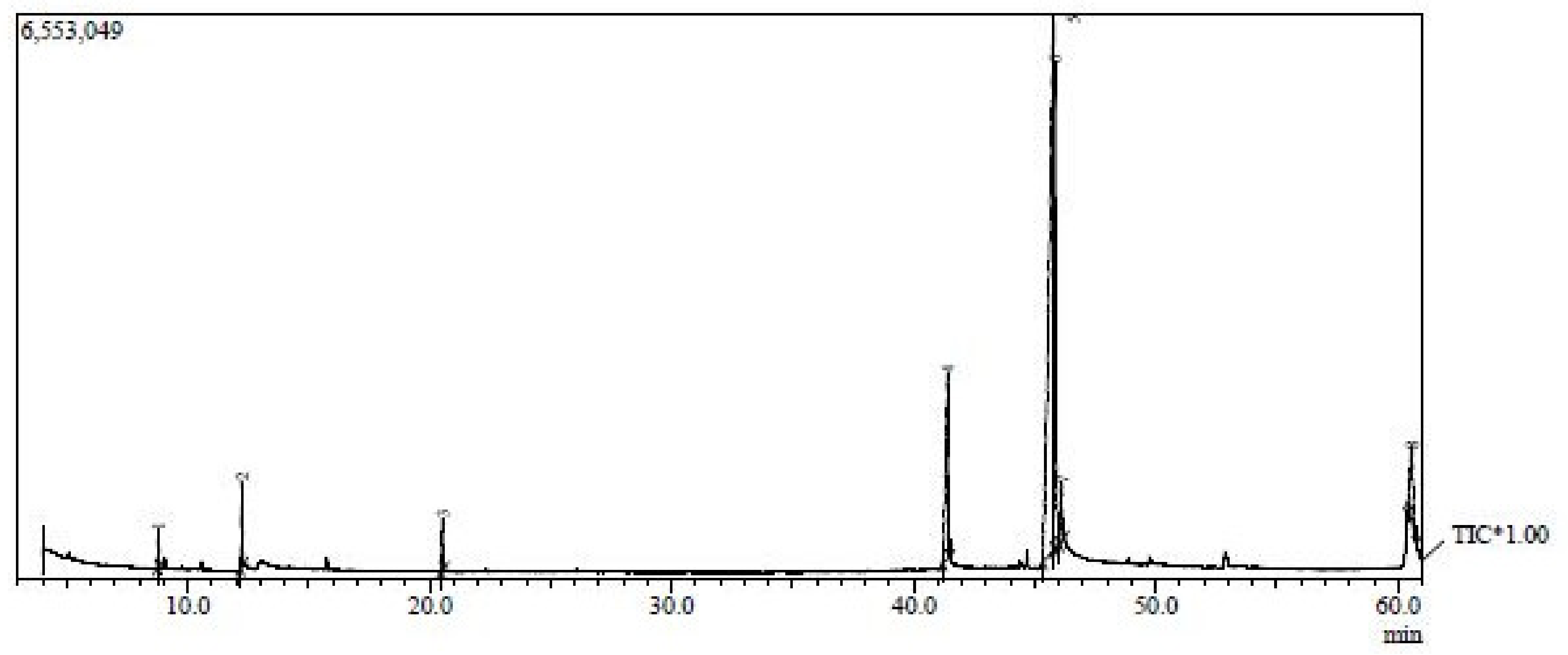

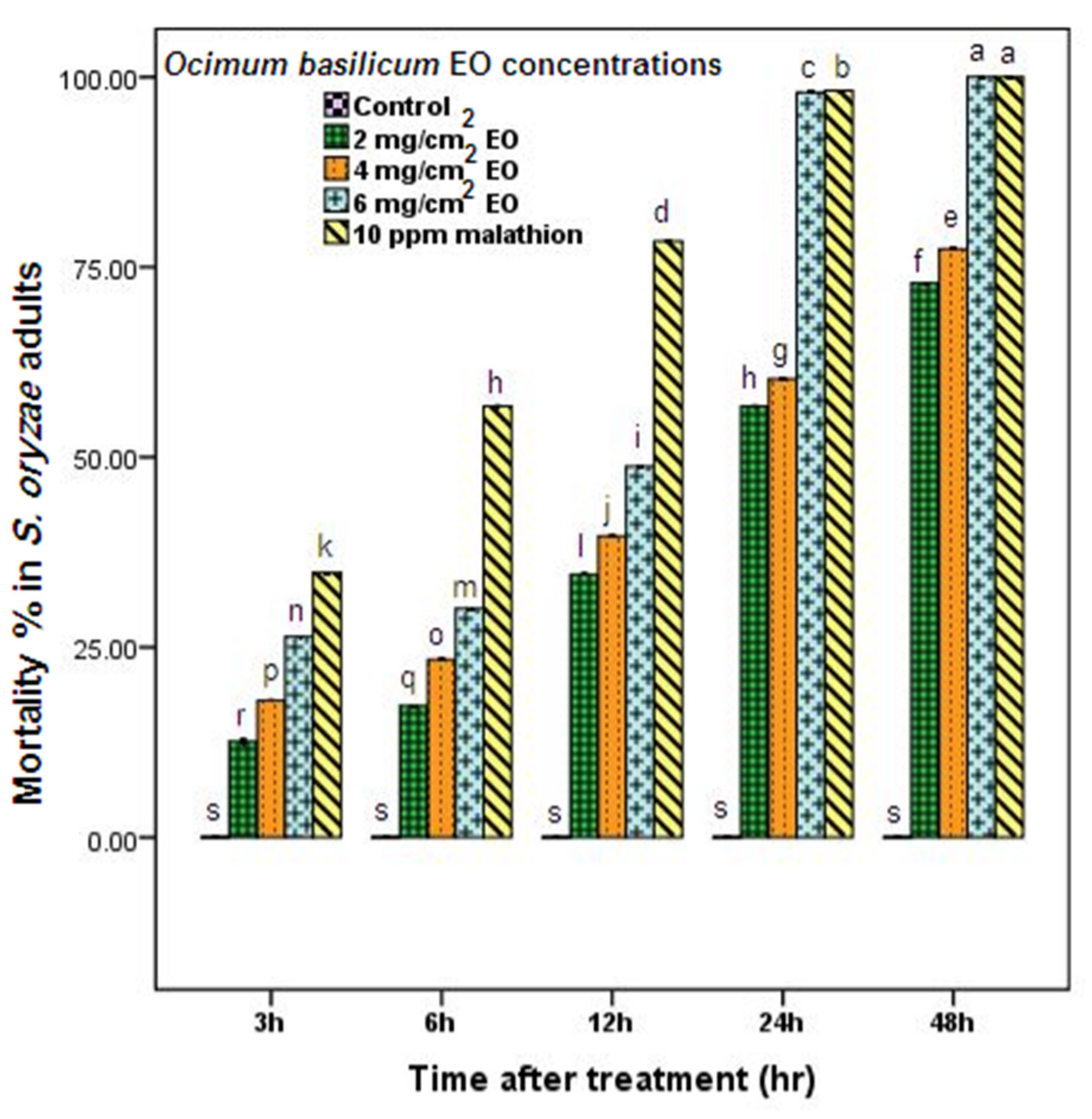
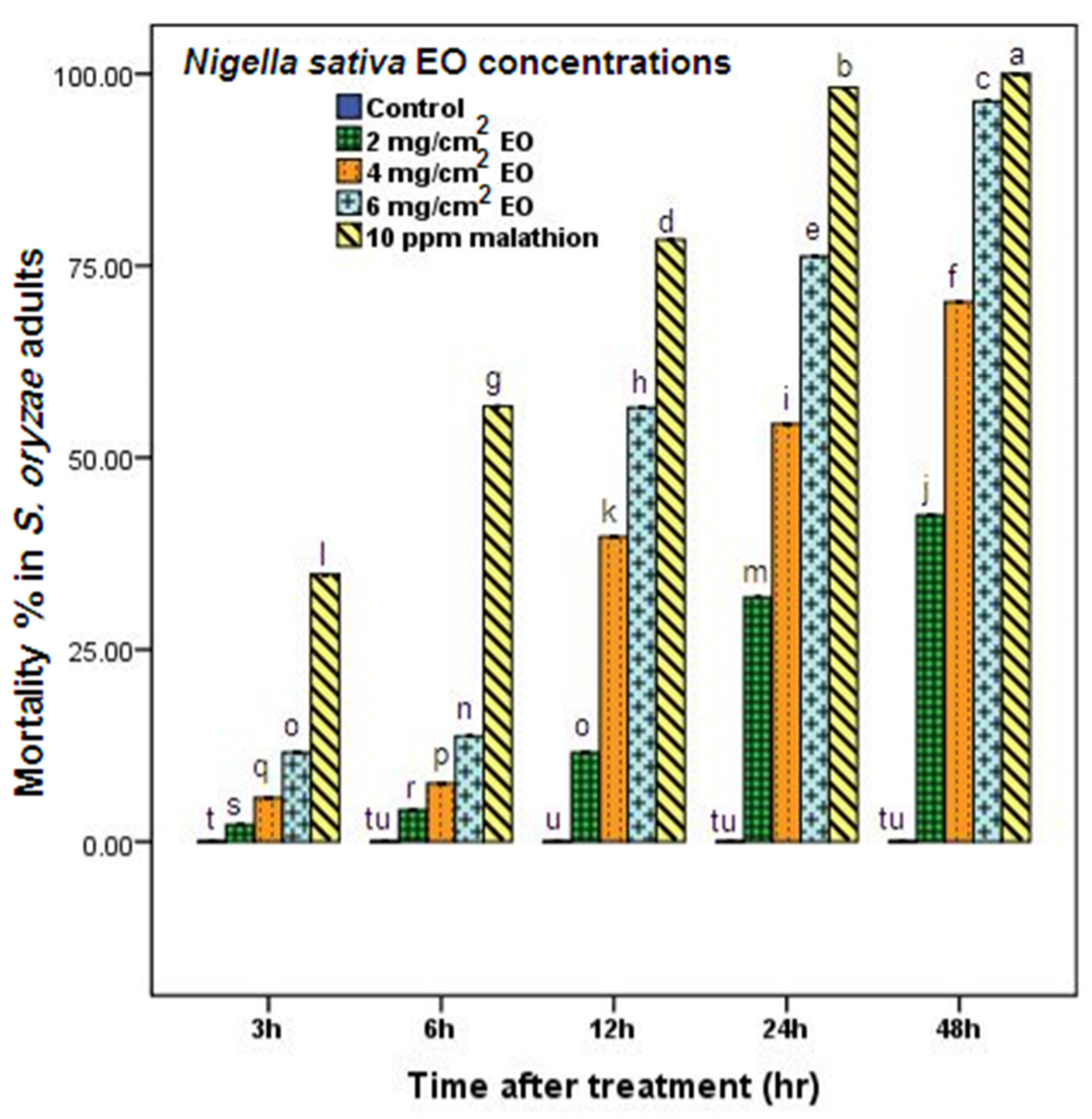
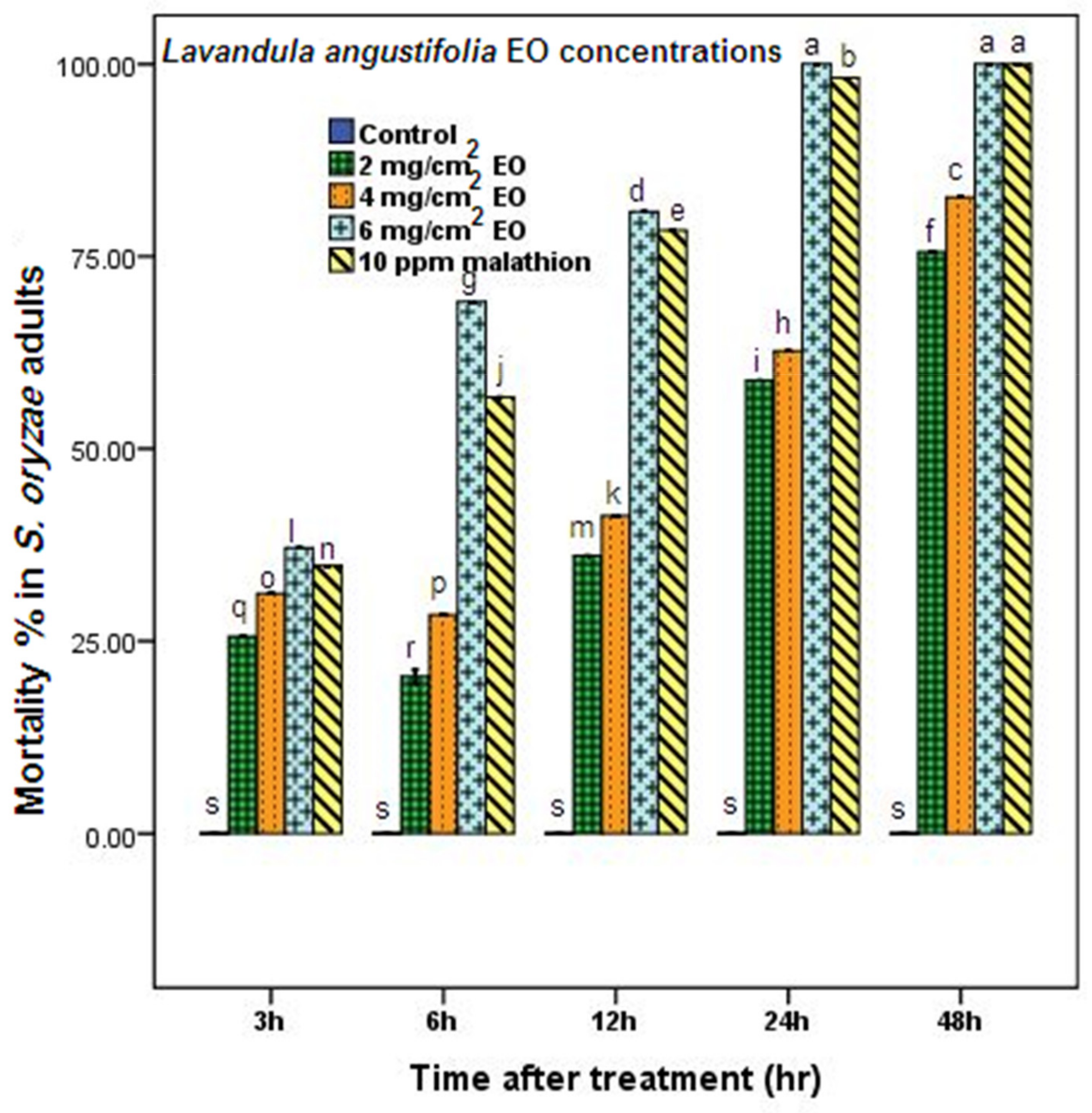
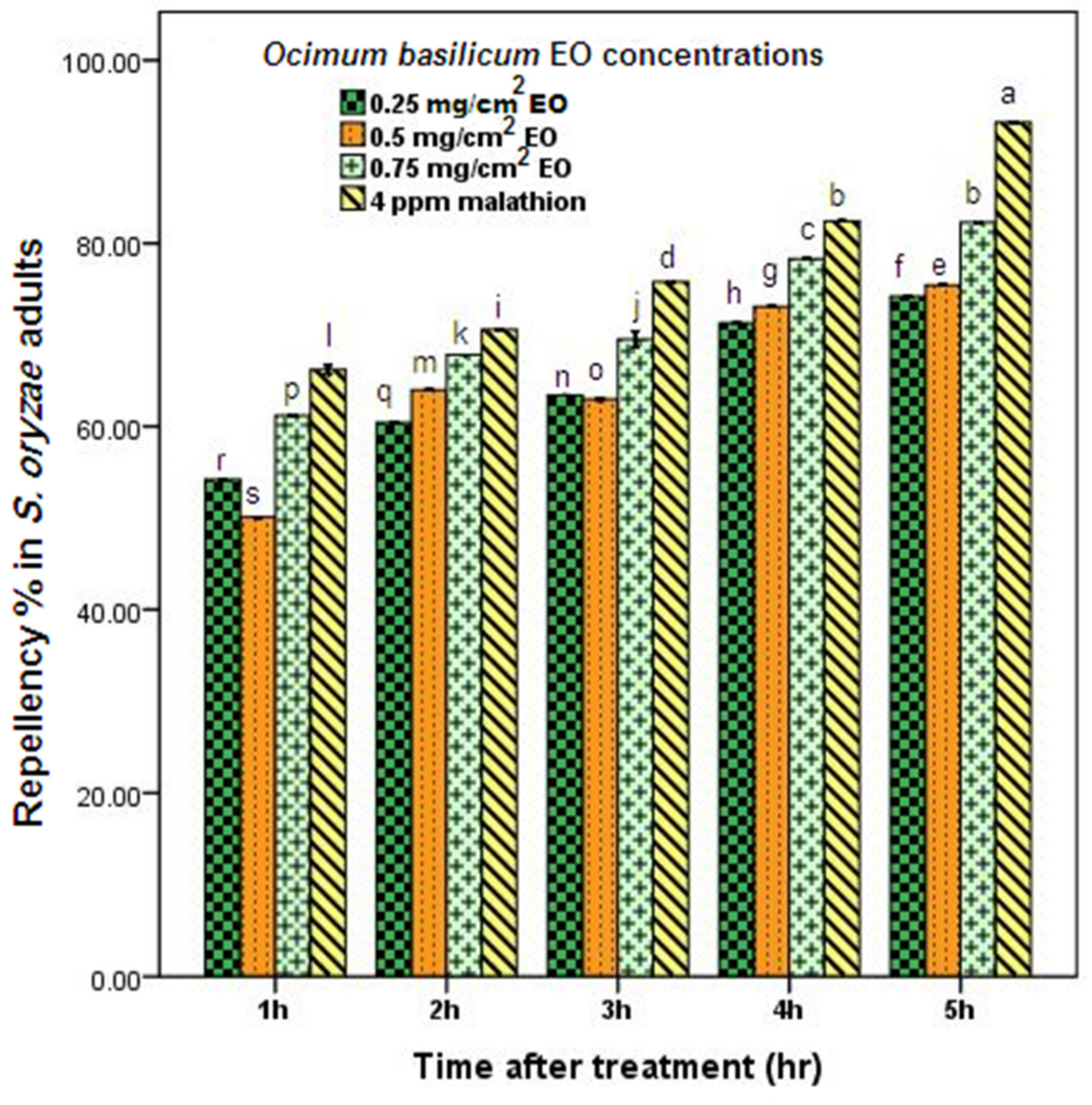
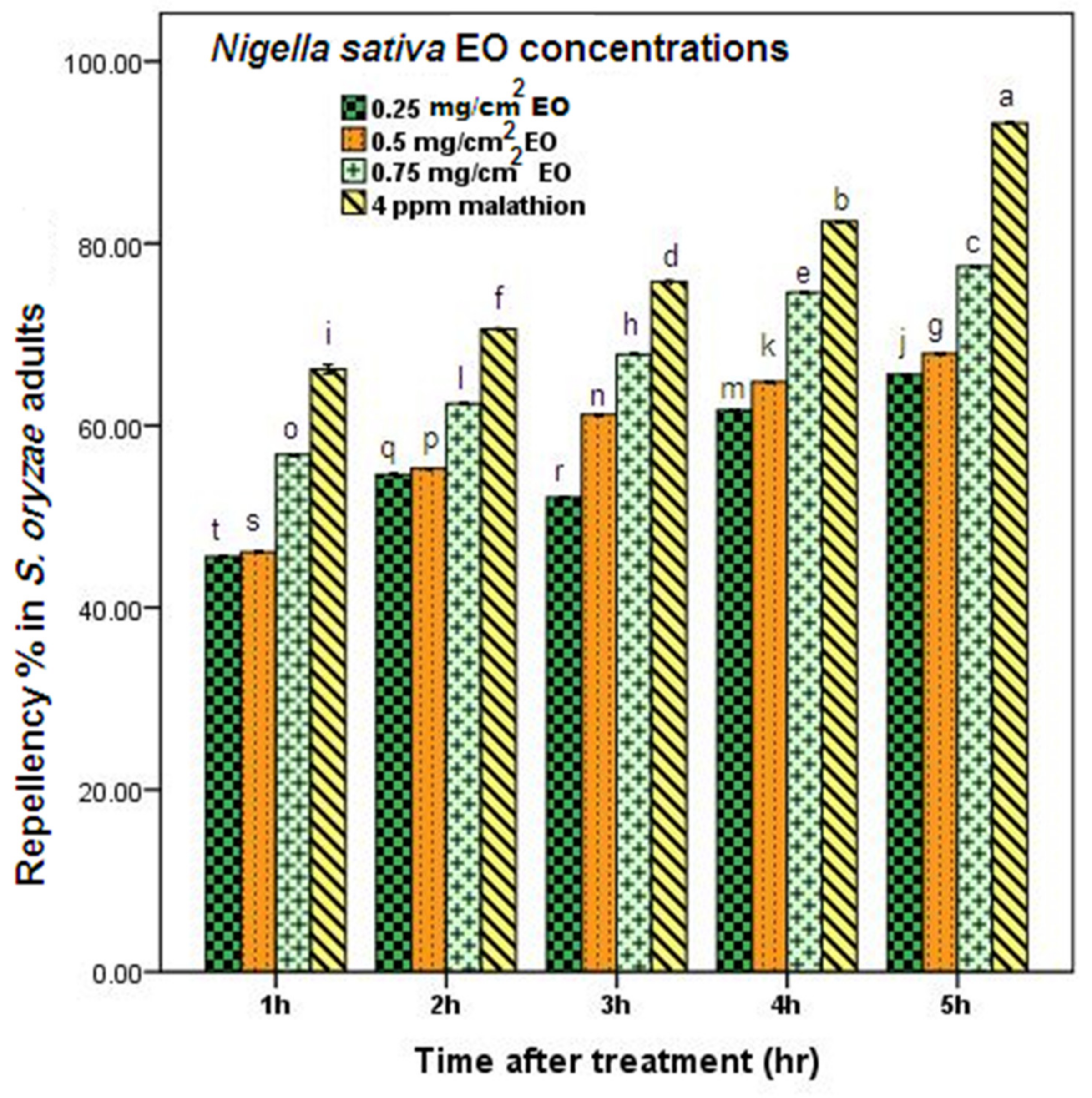
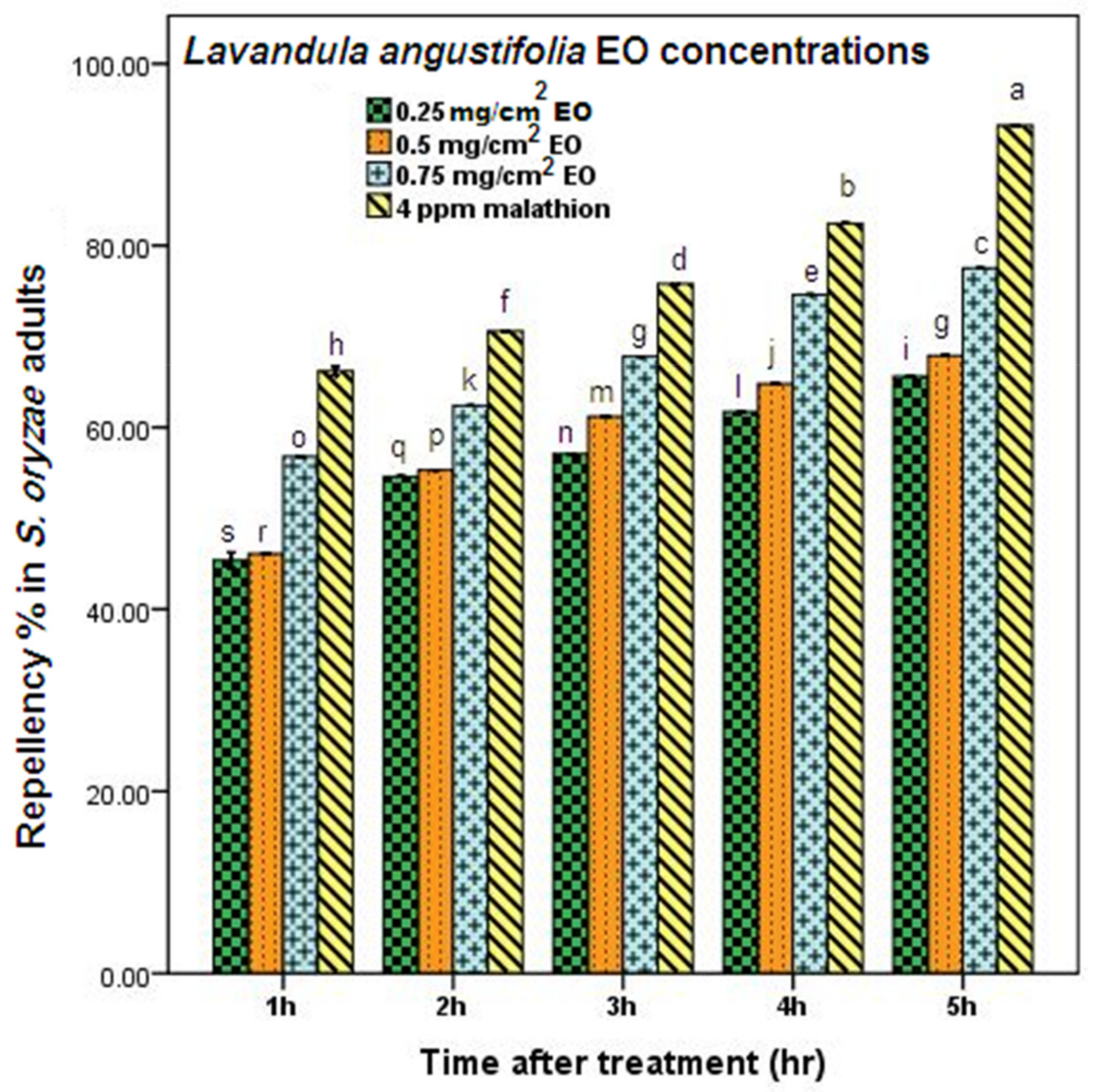
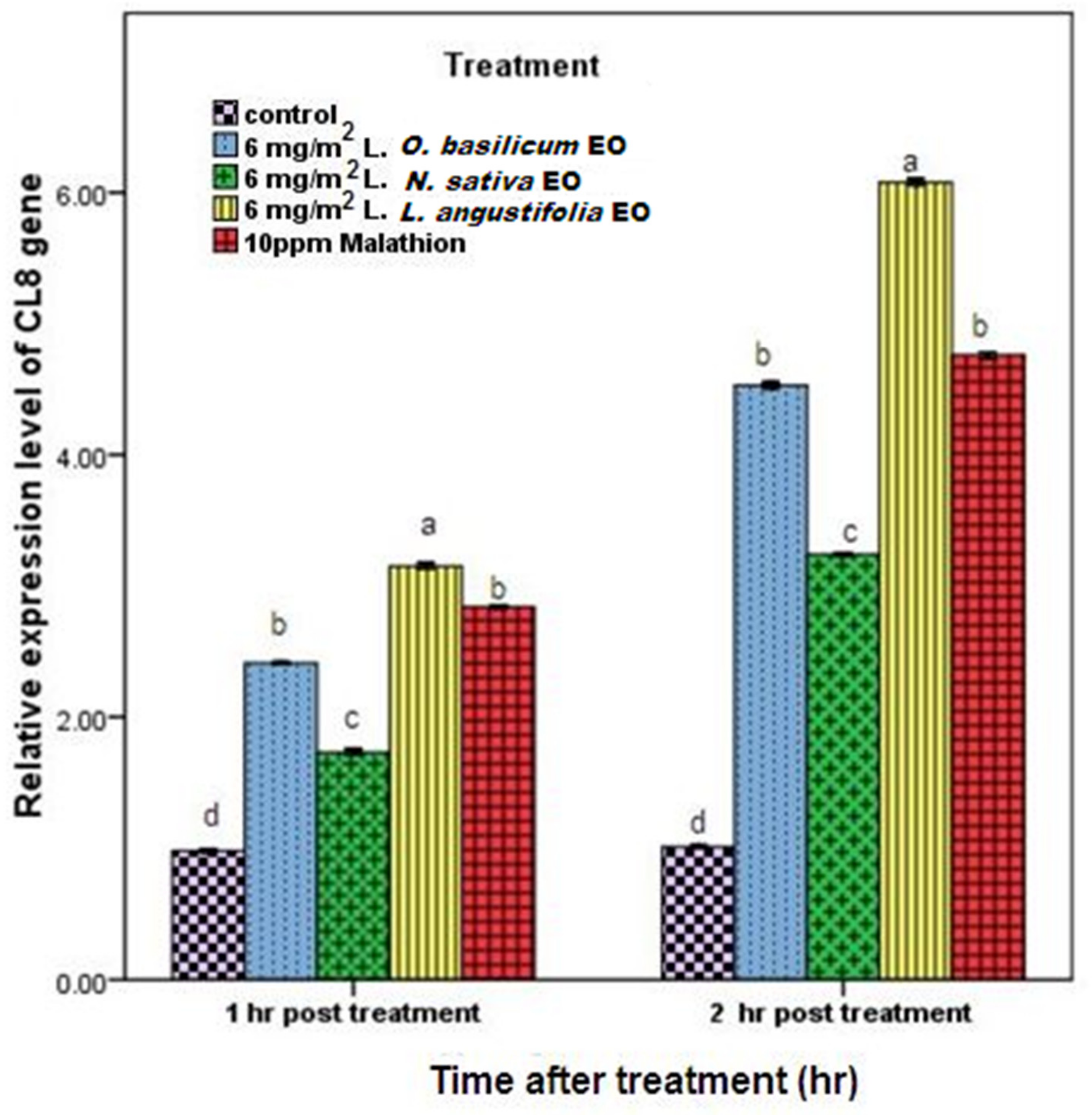
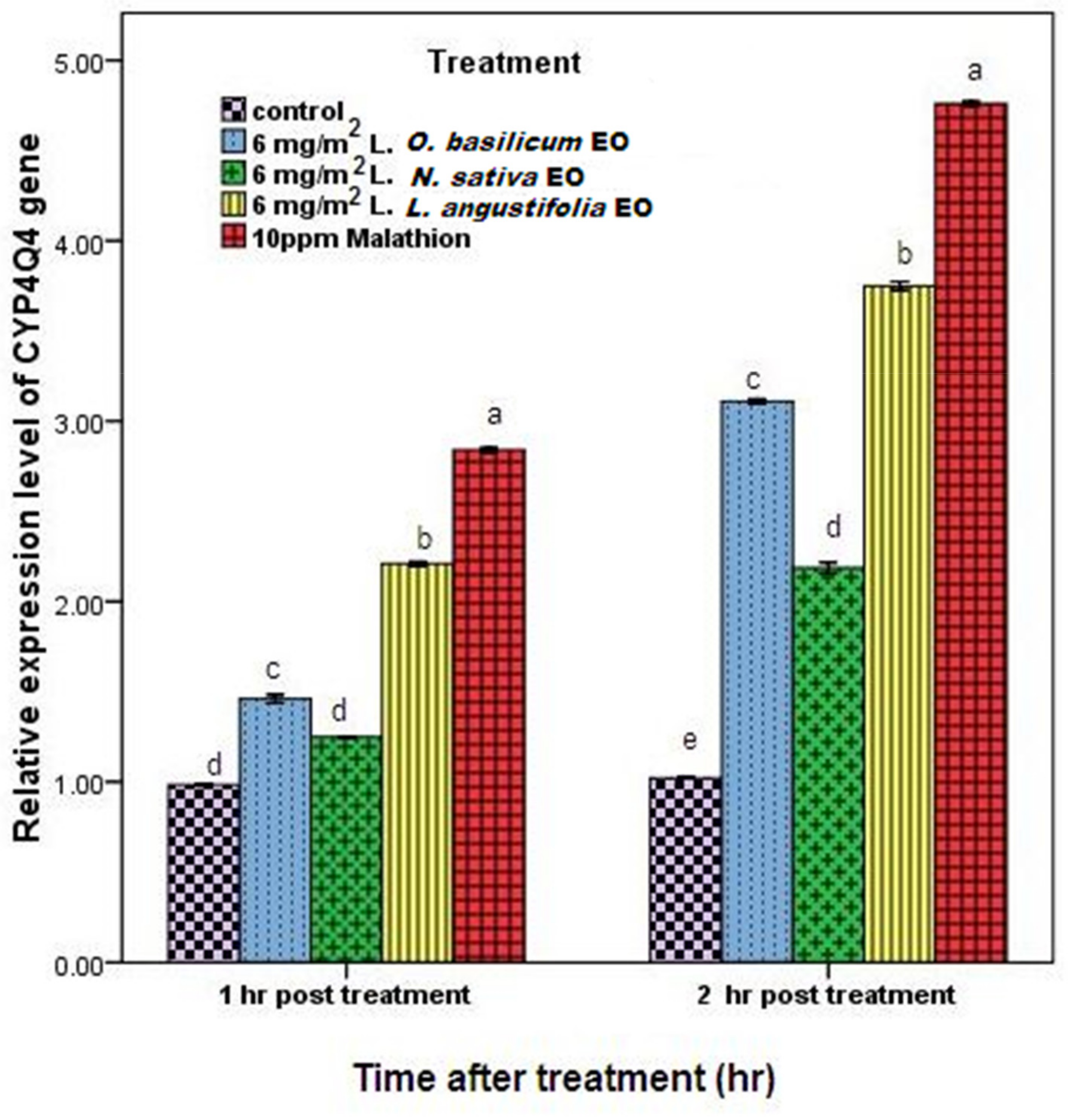
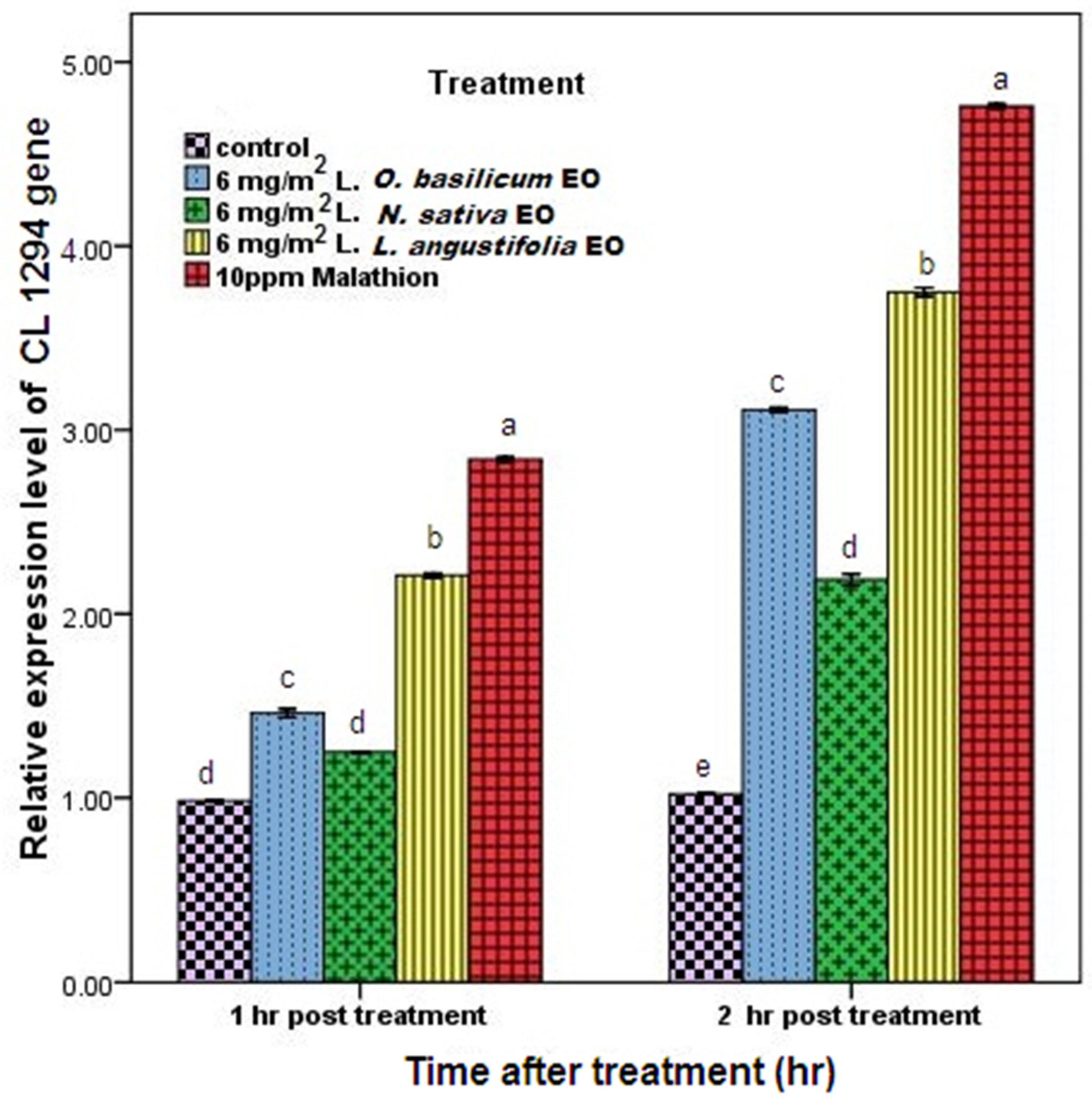
| Technique | Target Gene | Sequences (5′–3′) | Annealing °C |
|---|---|---|---|
| qRT-PCR | β-Actin-F | GACCTCTATGCCAACACAGT | 60 °C |
| β-Actin-R | AGTACTTGCGCTCAGGAGGA | ||
| CL8-F | CATCCGCAAACACAACAAAC | ||
| CL8 -R | TACCTGAAGGGTCCATATGG | ||
| CYP 4Q4-F | CAGTTTGGTGATTCAGATGATG | ||
| CYP 4Q4-R | GCACATCTGGGGACAAACTT | ||
| CL1294 –F | GTCTATGCACCTGGGTCGTT | ||
| CL1294 –R | GTCGGCAGACAAGGAAGACA |
| S. No. | Phytochemical Test | O. basilicum | N. sativa | L. angustifolia |
|---|---|---|---|---|
| 1 | Carbohydrate | + | - | - |
| 2 | Glycosides | + | + | - |
| 3 | Steroids | + | + | + |
| 4 | Terpenoids | + | + | + |
| 5 | Tannins | + | + | + |
| 6 | Sterols | + | + | + |
| Quantitative ID | Component Identified | RI | LRI | Area (%) | Identification |
|---|---|---|---|---|---|
| 1 | Glycolaldehyde | 873 | 923 | 3.27 | RI, MS |
| 2 | Trioxane | 686 | 660 | t | RI, MS |
| 3 | Methyl formate | 484 | 386 | t | RI, MS |
| 4 | 2-Chloroethanol | 688 | 680 | t | RI, MS |
| 5 | Acetic acid, 2-hydroxy-, ethyl ester | 829 | 918 | t | RI, MS |
| 6 | Acetic acid, hydrazide | 863 | 946 | 1.14 | RI, MS |
| 7 | (1S)-Camphor | 1121 | 1120 | 30.321 | RI, MS |
| 8 | Ethyl 3-(6-methoxy-3-methyl-2-benzofuranyl)-3-(p-methoxyphenyl) propionate | 2749 | 2838 | t | RI, MS |
| 9 | O-Ethyl S-[1-(4-methylphenyl)-2,3-diphenyl-2-cyclopropen-1-yl] carbonodithioate | 3401 | 3490 | t | RI, MS |
| 10 | 1-{2,4-Bis[(trimethylsilyl)oxy]phenyl}-2-{4-[(trimethylsilyl)oxy]phenyl}-1-propanone | 2631 | 2720 | t | RI, MS |
| 11 | Octamethylcyclotetrasiloxane | 827 | 994 | 9.936 | RI, MS |
| 12 | 2-Butyl-9(10H)-acridinone | 2342 | 2431 | t | RI, MS |
| 13 | Cridanimod | 2354 | 2443 | t | RI, MS |
| 14 | 10-Butyl-10H-acridin-9-one | 2169 | 2258 | 0.31 | RI, MS |
| 15 | 5-Amino-2-trimethylsilyloxy-acetophenone | 1639 | 1728 | 1.311 | RI, MS |
| 16 | 1-Acetyl-1,5-diazacycloheptadecan-6-one | 2550 | 2639 | t | RI, MS |
| 17 | 2,2-Bis[4-(dimethylamino)phenyl]-1-phenylethanone | 2835 | 2924 | 36.630 | RI, MS |
| 18 | Bis(3,4-dimethylphenyl) isophthalate | 3040 | 3087 | t | RI, MS |
| 19 | 2,5-Diphenyl-1,2-dihydro-3H-1,2,4-triazole-3-thione | 2483 | 2572 | t | RI, MS |
| 20 | Triamterene | 2829 | 2912 | 13.042 | RI, MS |
| 21 | 2-Amino-7-benzyl-4(1H)-pteridinone | 2525 | 2614 | t | RI, MS |
| 22 | 1,2-Dihydrobenzo[b]fluoranthene | 2246 | 2420 | t | RI, MS |
| 23 | 9-Phenanthrylmethyl 2,6-dimethylbenzoate | 3062 | 3109 | 2.84 | RI, MS |
| 24 | Propyl 2-tridecyn-1-yl terephthalate | 2849 | 2896 | nd | RI, MS |
| 25 | 2,3-Dichlorophenyl 2-fluoro-6-(trifluoromethyl)benzoate | 1916 | 2005 | t | RI, MS |
| 26 | 2,4-Dichloro-6-formylphenyl 2-fluoro-5-(trifluoromethyl)benzoate | 2218 | 2307 | nd | RI, MS |
| 27 | 9-Phenanthrylmethyl 2,6-dimethylbenzoate | 3062 | 3109 | t | RI, MS |
| 28 | Nonyl N-(4-ethylbenzoyl)glycinate | 2667 | 2756 | t | RI, MS |
| 29 | Undecyl N-(4-ethylbenzoyl)glycinate | 2866 | 2955 | t | RI, MS |
| 30 | Tridecyl N-(4-ethylbenzoyl)glycinate | 3065 | 3154 | t | RI, MS |
| 31 | Isobutyl N-(4-ethylbenzoyl)glycinate | 2106 | 2195 | t | RI, MS |
| 32 | 1,1′-(2,4,6-Trihydroxy-1,3-phenylene)di(1-propanone) | 2238 | 2327 | t | RI, MS |
| 33 | Propyl 2-fluoro-5-(trifluoromethyl)benzoate | 1181 | 1270 | t | RI, MS |
| 34 | 1-{2,4-Bis[(trimethylsilyl)oxy]phenyl}-2-{4-[(trimethylsilyl)oxy]phenyl}-1-propanone | 2631 | 2720 | t | RI, MS |
| 35 | 1-{2,4-Bis[(trimethylsilyl)oxy]phenyl}ethanone | 1625 | 1714 | t | RI, MS |
| 36 | Bis(2,5-dimethylphenyl) isophthalate | 3040 | 3087 | t | RI, MS |
| 37 | Pyridazinone | 885 | 968 | 0.518 | RI, MS |
| 38 | 4-Pyridazinol | 1122 | 1211 | nd | RI, MS |
| 39 | Decahydroquinoline | 1247 | 1330 | nd | RI, MS |
| 40 | N,N,2-Trimethyl-3-butyn-2-amine | 680 | 763 | nd | RI, MS |
| 41 | Allylcyclohexylamine | 1168 | 1251 | nd | RI, MS |
| 42 | 1,5-Bis(3-ethylphenoxy)-1,1,3,3,5,5-hexamethyltrisiloxane | 2422 | 2511 | nd | RI, MS |
| 43 | 1,5-Bis(2,5-dimethylphenoxy)-1,1,3,3,5,5-hexamethyltrisiloxane | 2450 | 2539 | nd | RI, MS |
| 44 | 1,1,3,3,5,5,7,7,9,9,11,11-Dodecamethylhexasiloxane | 1341 | 1430 | t | RI, MS |
| 45 | 2,3,4,5-Tetraethyl-7,7-diphenylbicyclo[4.1.0]hepta-2,4-diene | 2743 | 2798 | t | RI, MS |
| 46 | 1,1,3,3,5,5,7,7,9,9,11,11,13,13-Tetradecamethylheptasiloxane | 1526 | 1615 | t | RI, MS |
| 47 | Eugenol | 1392 | 1364 | 17.52 | RI, MS |
| 48 | Linalool | 1082 | 1100 | 12.31 | RI, MS |
| 49 | Estragole | 1172 | 1178 | 7.20 | RI, MS |
| 50 | Linalyl acetate | 1272 | 1254 | 30.43 | RI, MS |
| Quantitative ID | Component Identified | RI | LRI | Area (%) | Identification |
|---|---|---|---|---|---|
| 1 | β-Thujene | 873 | 920 | t | RI, MS |
| 2 | α-Thujene | 902 | 926 | 2.061 | RI, MS |
| 3 | α-Phellandrene | 969 | 1005 | t | RI, MS |
| 4 | p-Cymene | 1042 | 1021 | 7.244 | RI, MS |
| 5 | Thymoquinone | 1340 | 1276 | 1.145 | RI, MS |
| 6 | 4,4a,5,6,7,8-Hexahydro-4a-methyl-2(3H)-naphthalinone | 1357 | 1414 | t | RI, MS |
| 7 | 4-(3-Methyl-2-butenyl)-4-cyclopentene-1,3-dione | 1397 | 1454 | t | RI, MS |
| 8 | 2(5H)-Furanone, 4-(2,3-dimethyl-2-buten-4-yl)-5-methoxy- | 1493 | 1582 | t | RI, MS |
| 9 | (11E,13Z)-1,11,13-Hexadecatriene | 1618 | 1657 | t | RI, MS |
| 10 | 9-Hexadecenal | 1808 | 1805 | t | RI, MS |
| Pentadecanoic acid | 1869 | 1865 | t | RI, MS | |
| 11 | Palmitic acid | 1968 | 1963 | 9.936 | RI, MS |
| 12 | cis-10-Heptadecenoic acid | 2075 | 2073 | t | RI, MS |
| 13 | Methyl linoleate | 2093 | 2087 | t | RI, MS |
| 14 | Oleic acid chloride | 2131 | 2220 | 0.31 | RI, MS |
| 15 | Stearic acid | 2167 | 2161 | 1.311 | RI, MS |
| 16 | Oleic Acid | 2175 | 2171 | t | RI, MS |
| 17 | Linoleic acid | 2183 | 2134 | 56.630 | RI, MS |
| 18 | cis-11-Eicosenoic acid | 2374 | 2362 | t | RI, MS |
| 19 | 2-Chloroethyl linoleate | 2418 | 2458 | t | RI, MS |
| 20 | Erucic acid | 2572 | 2546 | 13.042 | RI, MS |
| 21 | 1-Oleoyl-rac-glycerol | 2689 | 2714 | t | RI, MS |
| 22 | 2-Oleoylglycerol | 2705 | 2780 | t | RI, MS |
| 23 | Trielaidin | 6149 | 6189 | 8.628 | RI, MS |
| Quantitative ID | Component Identified | RI | LRI | Area (%) | Identification |
|---|---|---|---|---|---|
| 1 | Hexanal | 806 | 819 | 10.44 | RI, MS |
| 2 | Cyclobutanol | 828 | 668 | t | RI, MS |
| 3 | Eucalyptol | 1059 | 1030 | 8.940 | RI, MS |
| 4 | Trifluoroacetyl-.alpha.-terpineol | 1167 | 1167 | t | RI, MS |
| 5 | Lavandulyl acetate | 1270 | 1273 | 19.24 | RI, MS |
| 6 | Linalool acetate | 1272 | 1261 | t | RI, MS |
| 7 | Eugenol | 1392 | 1356 | 29.35 | RI, MS |
| 8 | Isoeugenol | 1410 | 1451 | t | RI, MS |
| 9 | Linalyl butyrate | 1471 | 1422 | t | RI, MS |
| 10 | Bicyclo[10.1.0]tridec-1-ene | 1472 | 1472 | 14.69 | RI, MS |
| Hexyl cyclohexanecarboxylate | 1544 | 1509 | nd | RI, MS | |
| 11 | Eugenol acetate | 1552 | 1523 | t | RI, MS |
| 12 | 8-Hexadecyne | 1629 | 1629 | 1.031 | RI, MS |
| 13 | 9,12-Tetradecadien-1-ol, (Z,E)- | 1672 | 1677 | t | RI, MS |
| 14 | 9-Hexadecyn-1-ol | 1872 | 1863 | t | RI, MS |
| 15 | 9-Hexadecenoic acid | 1976 | 1953 | 0.65 | RI, MS |
| 16 | Cyclohexanecarboxylic acid | 2031 | 2084 | nd | RI, MS |
| 17 | 1,6-Octadien-3-ol, 3,7-dimethyl-, 2-aminobenzoate | 2157 | 2175 | 15.35 | RI, MS |
| 18 | Vaccenic acid | 2175 | 2141 | t | RI, MS |
| 19 | Cyclohexanecarboxylic acid, 2-tridecyl ester | 2176 | 2168 | nd | RI, MS |
| 20 | Linoleic acid | 2183 | 2128 | 12.76 | RI, MS |
| 21 | Oxacycloheptadec-8-en-2-one | 2246 | 2206 | t | RI, MS |
| 22 | cis-10-Nonadecenoic acid | 2274 | 2225 | t | RI, MS |
| 23 | Cyclohexanecarboxylic acid, 2-tetradecyl ester | 2275 | 2267 | nd | RI, MS |
| 24 | 2-cis,cis-9,12-Octadecadienyloxyethanol | 2344 | 2344 | t | RI, MS |
| 25 | 9-Decenyl laurate | 2365 | 2365 | nd | RI, MS |
| 26 | cis-11-Eicosenoic acid | 2374 | 2362 | 13.48 | RI, MS |
| 27 | Erucic acid | 2572 | 2546 | 0.23 | RI, MS |
| 28 | cis-13,16-Docasadienoic acid | 2580 | 2566 | t | RI, MS |
| 29 | Isocaryophyllene | 1434 | 1427 | 2.67 | RI, MS |
| Phytochemistry | Basil | Black Seeds | Lavender |
|---|---|---|---|
| TPC (mg GAE/g) | 31.4 | 17.8 | 23.4 |
| TFC (mg RE/g) | 17.6 | 9.7 | 12.5 |
| DPPH (%) | 18.9 | 16.4 | 11.2 |
Publisher’s Note: MDPI stays neutral with regard to jurisdictional claims in published maps and institutional affiliations. |
© 2021 by the authors. Licensee MDPI, Basel, Switzerland. This article is an open access article distributed under the terms and conditions of the Creative Commons Attribution (CC BY) license (https://creativecommons.org/licenses/by/4.0/).
Share and Cite
Al-Harbi, N.A.; Al Attar, N.M.; Hikal, D.M.; Mohamed, S.E.; Abdel Latef, A.A.H.; Ibrahim, A.A.; Abdein, M.A. Evaluation of Insecticidal Effects of Plants Essential Oils Extracted from Basil, Black Seeds and Lavender against Sitophilus oryzae. Plants 2021, 10, 829. https://doi.org/10.3390/plants10050829
Al-Harbi NA, Al Attar NM, Hikal DM, Mohamed SE, Abdel Latef AAH, Ibrahim AA, Abdein MA. Evaluation of Insecticidal Effects of Plants Essential Oils Extracted from Basil, Black Seeds and Lavender against Sitophilus oryzae. Plants. 2021; 10(5):829. https://doi.org/10.3390/plants10050829
Chicago/Turabian StyleAl-Harbi, Nadi Awad, Nagy M. Al Attar, Dalia M. Hikal, Salwa E. Mohamed, Arafat Abdel Hamed Abdel Latef, Amira A. Ibrahim, and Mohamed A. Abdein. 2021. "Evaluation of Insecticidal Effects of Plants Essential Oils Extracted from Basil, Black Seeds and Lavender against Sitophilus oryzae" Plants 10, no. 5: 829. https://doi.org/10.3390/plants10050829
APA StyleAl-Harbi, N. A., Al Attar, N. M., Hikal, D. M., Mohamed, S. E., Abdel Latef, A. A. H., Ibrahim, A. A., & Abdein, M. A. (2021). Evaluation of Insecticidal Effects of Plants Essential Oils Extracted from Basil, Black Seeds and Lavender against Sitophilus oryzae. Plants, 10(5), 829. https://doi.org/10.3390/plants10050829










